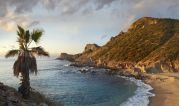25 facts about Guatemala

1. Country name means "the place where many trees grow". It was given to the area by Tlaxcaltec’s Indians who accompanied to the Spanish conquistador Pedro de Alvarado, which came here in 1523.
2. BBC listed Guatemala in the first place of the list of 10 best vacation places in the cultural sector.
3. Guatemala is called the land of eternal spring.
4. Guatemala is one of the most popular places in the world to shoot movies and music videos. For example, the movie "Spy Kids" was filmed here.
5. The sacred bird of Mayas and Aztecs is represented on the flag of Guatemala. It is Quetzal. By the way, the national currency of Guatemala has the same name. A Quetzal bird itself now lives in the forests of Central America.

6. Guatemala's national tree is the ceiba. It grows throughout the country and reaches 50 m in height. The indigenous population of the country still believes that ceiba is the sacred tree, and spends holidays, arranges markets in the shade of green giants.
7. The country has a national flower officially established on February 21, 1934. It’s an orchid Lycaste virginalis, known here as the "white nun".

8. There are 33 volcanos in Guatemala.
9. Guatemala is the only country in Latin America with four active volcanoes.
10. Guatemala is the second largest producer of sugarcane in the world and the fifth exporter of this product.
11. The largest number of different species of coniferous trees, which serve to wood production, grows in the country.
12. Guatemala is a major supplier of the highest quality coffee for the company «Starbucks».
13. The instant coffee was invented in Guatemala in 1910 by doctors of medicine Federico Lehnhoff and Eduardo Cabarrus.

14. An Arabica variety called Maragogype grows in Guatemala. Its special feature is the particularly large grain, which size exceeds about 2 times the one of other varieties.
15. The third university in the Americas was founded in Guatemala. It’s the University of San Carlos.
16. More than a half of Guatemalans participate in some civil organization.
17. The residents are proud of the Nobel Prize, received by their countrymen: the Prize for Literature, which was obtained by Miguel Angel Asturias in 1967, and the Peace Prize, which Rigoberta Menchu was awarded with in 1992.
18. Alvaro Arzu Irigoyen Enrique, the 32nd President of Guatemala, was elected as a mayor of the capital for five times, and was recognized as one of the best "monarch of the city" of the world.
19. Guatemala City is divided into squares and consists of 25 zones. The streets here basically do not have names, they are replaced by numbers.

20. Due to the action of Prohibition, all the bars in Guatemala City close at 01:00 a.m., but there are special places, usually ”camouflaged” as garages, where you can drink until 3:30 a.m.
21. Mixco Viejo is the archaeological site of the Mayan culture, which is just a 35-minute drive from the capital. It's a great place for birdwatching: the species living here have a bright plumage.
22. In Lachua lagoon, which is located in Coban, the fishing is banned, so the fish living there meet the divers curiously. If one of them is freezing for some time, the fish approaches to at a very close distance, and some species even try to taste whether his birthmarks or even hair is edible.

23. Despite the external cold, the water temperature in Guatemalan Atitlan Lake increases during dawn. Until now, the scientists have not been able to find the reasons for this phenomenon.
24. There is a waterfall Paraiso on the shores of Lake Izabal. Its uniqueness is that the water falling from a height of about 8 meters is hot!
25. The Guatemalan marimba is one of the musical instruments least studied in the world today. The process of its creating is very complex, and to play this instrument from 6 to 12 people are set in motion.

Speaking about the diversity and beauty of Mexico, we don’t try to embellish: this land really abounds in places of great beauty. But now we want to offer you to get acquainted with those of them that are, in fact, unique!

Tequila is world famous drink now that was first manufactured in the Mexican city of Tequila, state of Jalisco. Tequila is produced by fermentation and distillation of the blue agave juice in five states of Mexico: in 7 municipalities of Guanajuato, 30 of Michoacan, 8 of Nayarit (in the areas, which are close to the state of Jalisco), in 11 municipalities of Tamaulipas and, of course, throughout the state of Jalisco.















